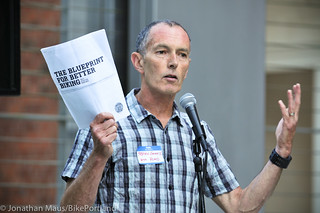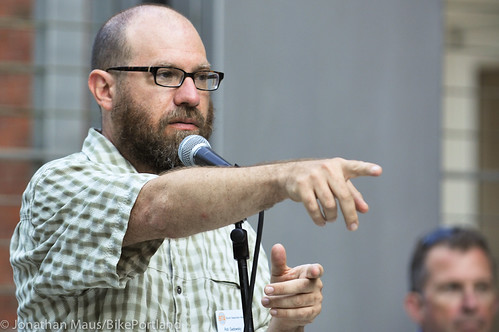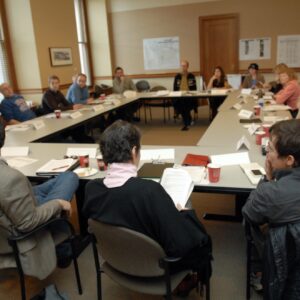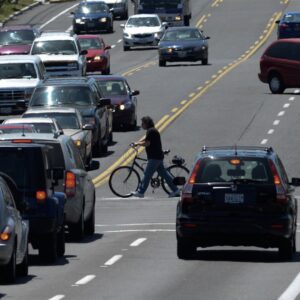
their annual member meeting
Wednesday night.
(Photos © J. Maus/BikePortland)
At their annual meeting Wednesday night, the Bicycle Transportation Alliance (BTA) launched an effort to identify and prioritize a list of projects that will update their ‘Blueprint for Better Bicycling.’ The BTA’s first Blueprint, a report that identified a list of their top 40 infrastructure projects around the region, was released nearly seven years ago.
Along with announcing the start of a process to develop a new Blueprint report, the BTA offered an update on how those projects have fared since 2005. Addressing the crowd of members as they milled around the Portland Art Museum Sculpture Garden dining on tacos and beer (served by bike by Taco Pedaler and the Hopworks Beer Bike), BTA Board Director Stephen Gomez reflected on the 2005 project list. “I can’t say we’ve had success with everything on this list. But the list, it really matters.”
According a status report on the 2005 Blueprint for Better Bicycling released by the BTA yesterday, nine of their top 40 projects have been completed, 22 are “in progress”, six are “static” and three have been “denied.” Here’s the breakdown:
Success:
– Morrison Bridge
– Rose Quarter
– NE Cully Blvd
– Low-Speed/Low-Volume Bikeways (Top 10)
– Signs and Markings
– Tourism Center
– Car-Free Events
– Bike Parking
– Oregon Center for Bicycling and Walking
In Progress:
– Sellwood Bridge (Top 10)
– South Waterfront Path
– Central City Bicycle Plan (Top 10)
– North Portland Greenway Trail
– N/NE Portland – New East-West Bikeways (Top 10)
– I-5 Bike Path Crossings
– Gresham-Fairview Trail
– Springwater Corridor to Mt. Hood
– North-South Eastside Bikeways
– Close the Springwater Gap
– Willamette Shore Trail (Top 10)
– Trolley Trail
– Tonquin Trail (Top 10)
– Westside Trail
– Low Traffic Suburban Routes (Top 10)
– Gaps in Suburban Bikeways
– Fanno Creek Trail (Top 10)
– Employer Based Incentive Programs
– Enforcement Campaigns (Top 10)
– Education Campaigns
– Safe Routes to School (Top 10_
– MAX Station Bicycle Hubs
Static:
– NW Flanders St. Bike Boulevard
– I-5 Bridge Access
– 92nd Ave
– Stafford Road
– SW Hall Blvd
– Maintenance of Bikeways
Denied:
– St. Johns Bridge
– Lake Oswego to Milwaukie Crossing
– West Linn to Oregon City Crossing
(For more on each of these projects, download a PDF of the 2011 Blueprint Status Report)
“We get asked to do everything, so this is a chance for us to say, ‘These are our top priorities.'”
— Rob Sadowsky, BTA
Of all the projects and policies mentioned in the 2005 Blueprint, the thing the BTA helped the most (in my opinion) was to popularize and champion bike-friendly neighborhood streets also known as bike boulevards and the Bureau of Transportation’s (PBOT) moniker of neighborhood greenways. The BTA support of bike boulevards back then — outlined clearly in the Blueprint — laid a key foundation that allowed PBOT to take big steps in the following years.
Another way the Blueprint can be powerful is as an advocacy tool to garner leverage with City Hall, PBOT staff, and other agencies and local leaders. If a local planner, city staffer, or politician is keen on a certain project that’s on the Blueprint list, they can say, “We should do this, because it’s in the BTA’s Blueprint report.” (Much like is often done with the projects listed in the Portland Bike Plan for 2030.)
BTA Executive Director Rob Sadowsky said the Blueprint is all about framing their future work. “We get asked to do everything, so this is a chance for us to say, ‘These are our top priorities.'”
To start the new process of picking projects, the BTA will launch a social media campaign and an online survey (to launch Monday) where everyone can pick from a list of projects and/or suggest their own. They also plan to send staff to neighborhood coalition offices to make presentations and ask for feedback. In addition to infrastructure projects, Sadowsky says the new Blueprint will also include policies they hope to pursue or change. “We want every project to be both inspiring and aspiring.”
The social media campaign will ask riders to record and submit 15-30 second videos describing gaps in their favorite routes.
The BTA will see which projects get the most votes, analyze how those projects stack up with their newly adopted Strategic Plan and other priorities (getting more people on bikes and reducing crashes are their top two Sadowsky said), discuss the input with their Board, and then come up with a new list of top projects. Sadowsky says they haven’t decided if they’ll release a top 40 for the entire region or a top five list for each different county and neighborhood.
Once the list is set, the work begins. “We’ll put our resources behind it, use it to raise dollars — both public and private — to get these projects done,” Sadowsky shared, “and make sure our elected officials are aware and understand the importance of the list.”
— Learn more on the BTA’s website.






Overall, lots of progress and BTA should be proud. There are a lot of huge wins here, mostly things that ought to have been included in our transportation system from the start, but in reality it took a lot of advocacy and hard work to make it happen, and I’m grateful to BTA for it.
A couple of things, though:
I would rate “Signs and Markings” as “In Progress” rather than “Success.” It’s far from done. I do love the new routefinding signs (which, FWIW, I cited as a critical need in the project I did when I took the Portland Traffic and Transpo class back in 2002). They are a HUGE improvement to our previous (lack of) bikeway signage, but we have a long way to go. Last night I rode home from PDX airport to my home in Brooklyn, using the “40s bikeway” from Fernhill Park to Clinton St. Most of this route is unfamiliar to me so I was entirely dependent on the signs and pavement markings. Some of my observations:
– There are two different styles of the “new” routefinding signs, and many critical intersections on the bikeways still have the old “bike route” signs rather than the new signs. So you have to watch for 3 kinds of signs.
– Sometimes the pavement is marked with huge sharrows, and in other places with small round (about 12-16″ diameter?) symbols, so (in addition to 3 kinds of signs) you have to look for 2 different kinds of pavement markings. In one place on a bikeway I saw a sharrow pointing one direction, and — RIGHT NEXT to it — a round symbol pointing the opposite direction!
– A number of critical intersections, where the bikeway makes a turn or a jog, are STILL NOT signed. At least 4-6 times last night I found myself wondering which way to go, and having to look at the pavement markings 50-100′ down side streets to verify which was the continuation of the route — difficult in broad daylight, impossible at night. I mostly found my way by a combination of this and intuition, but even then I found myself off route at one point where there were no signs or pavement markings. Try doing what I did last night in the dark, and you WOULD get lost.
– Some of the old style “bike route” signs are outright misleading or wrong. There were one or two places, at intersections between bike routes, where the sign appeared to indicate that my route turned left or right. In actuality my route continued straight, and it was the intersecting route that went right or left. The sign should have indicated both options.
On another note, I’m a little surprised I don’t see the Red Electric route on the 2005 list. This has been a known need for many years. Yes it will be very expensive, but it’s important when you consider that there is still NO safe, low-traffic, efficient route between Portland and Beaverton/Hillsboro, its largest suburban employment center.
This is cool. SW Portland should be a priority too. What major connections does SW Portland have to downtown that encourage an increase in cycling? Barber, Terwilliger and the Corbett-Spring Water connection come to mind. What can we do to increase the cycling traffic for the SW?
And the “very expensive” part will be no trouble since regional governments are awash in money.
Maybe you intended “efficient” to include “fast”, but I would still add “fast” to that list of requirements. I’m trying to get to and from work most of the time when I’m riding in southwest.
My fear of the Red Electric trail is that if it is ever constructed, it will be used as an excuse to further neglect or even decommission the bike lanes on Beaverton-Hillsdale. Going westbound I can manage 20 mph there. I don’t see that happening on a MUP, with kids, dog walkers, and the homeless drinking parties (see Jonathan’s other story about the Springwater.) My commute currently takes about 45 minutes. I don’t want that time increased.
Maybe ask the people who are riding in southwest, currently, what works for them, what doesn’t, what they would like fixed, and maybe do more of what works and address the fix list?
My short fix list: fix Beaverton-Hillsdale/Oleson/Scholls, especially westbound. Complete Garden Home Road and 92nd between Allen and Oleson with bike lanes and sidewalks. Repaint BH and Barbur bike lane stripes. Get the blackberry vines and other vegetation out of the bike lane on Capitol and BH, either by actively coercing the adjacent property owners or sending out a city crew to do it, right now today, and bill those property owners for the overtime.
Instead the BTA is concentrating on trying to lure a demographic which is not riding now, which says it might if only all the negatives were eliminated. Most frequently cited negative is motor vehicle traffic. Even if that negative were totally eliminated, I don’t believe that demographic will then turn to bicycling. Instead they will find other excuses, such as that it rains, it gets dark, Johnny has to be ferried to soccer practice, there are sketchy homeless people hanging out on the MUP, etc.
You really think they’d ever remove the bike lanes from BHH? I don’t. In fact, I’m positive that over time they will ADD them to BHH to the west of Oleson/Scholls Ferry, so we have a complete route.
I do often ride BHH because it is efficient (and by that I DO mean “fast”), and it is more efficient than Red Electric will be. I always take BHH when I’m going westbound, because it is so fast and efficient — though that isn’t very often because I’m always pinched for time in the morning and usually take the MAX instead.
Eastbound, though, when I’m not going anywhere near as fast due to the grade, I still take BHH if I’m in a hurry, especially in clear weather. but I also recognize that it is considerably more hazardous than alternate routes on quieter streets. Especially with driver distraction skyrocketing, this is one route where I do not see the level or risk going down as bike ridership goes up. I’m trying to manage my overall cumulative risk, so I often take MUCH slower alternate routes, especially in winter.
A completed Red Electric Trail would not be as fast/efficient as BHH itself, but it would be much safer, and considerably more efficient than the current alternatives. I’m not too worried about all the other MUP users, because in nice weather I would probably still take BHH a lot of the time; when I really need it is when it’s crappy out and BHH becomes more dangerous.
I agree with Seth that fixing BHH/Scholls/Oleson, which is an absolute nightmare and cyclists have no choice BUT to ride through (unless we want to detour miles out of our way). And I’m almost positive that west of that intersection, BHH has enough pavement to add bike lanes nearly the entire distance from Scholls to 217 while maintaining all the existing travel lanes to the 12′ standard. I’m guessing it’s only out of laziness that ODOT has not already done this.
I agree these would be good priorities to have on BTA’s list.
I wish that “Build BTA Board Consensus around opposing any future all-ages helmet law” were on this list. I’m not restarting my membership with the BTA until they repeal their announcement that they would not oppose a mandatory all-ages helmet law, or at least for a number of years till the memory of that self-inflicted injury fades. Such a law, were it proposed, would be disastrous for biking in Oregon. The fact that the Board spent their time debating such a silly move spoke volumes, and the fact that they decided to not oppose such a law speaks more. I’m glad that the BTA seems to be recovering from their multiple self-inflicted wounds but they simply must oppose any mandatory helmet law in order to avoid a large decline in cycling (not just due to the hassle of putting on a helmet – mostly due to the optics of the government officially saying that biking is a Dangerous Activity).
Please don’t restart the general should-people-wear-helmets debate in replies to this comment. If you want to debate the BTA’s position on helmets that’s fine (though I’m sure Jonathan would prefer that we talk about something more on-topic to the article).